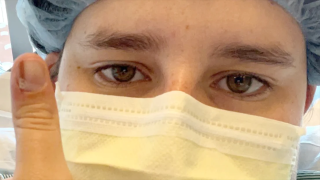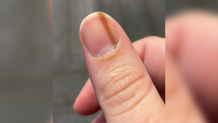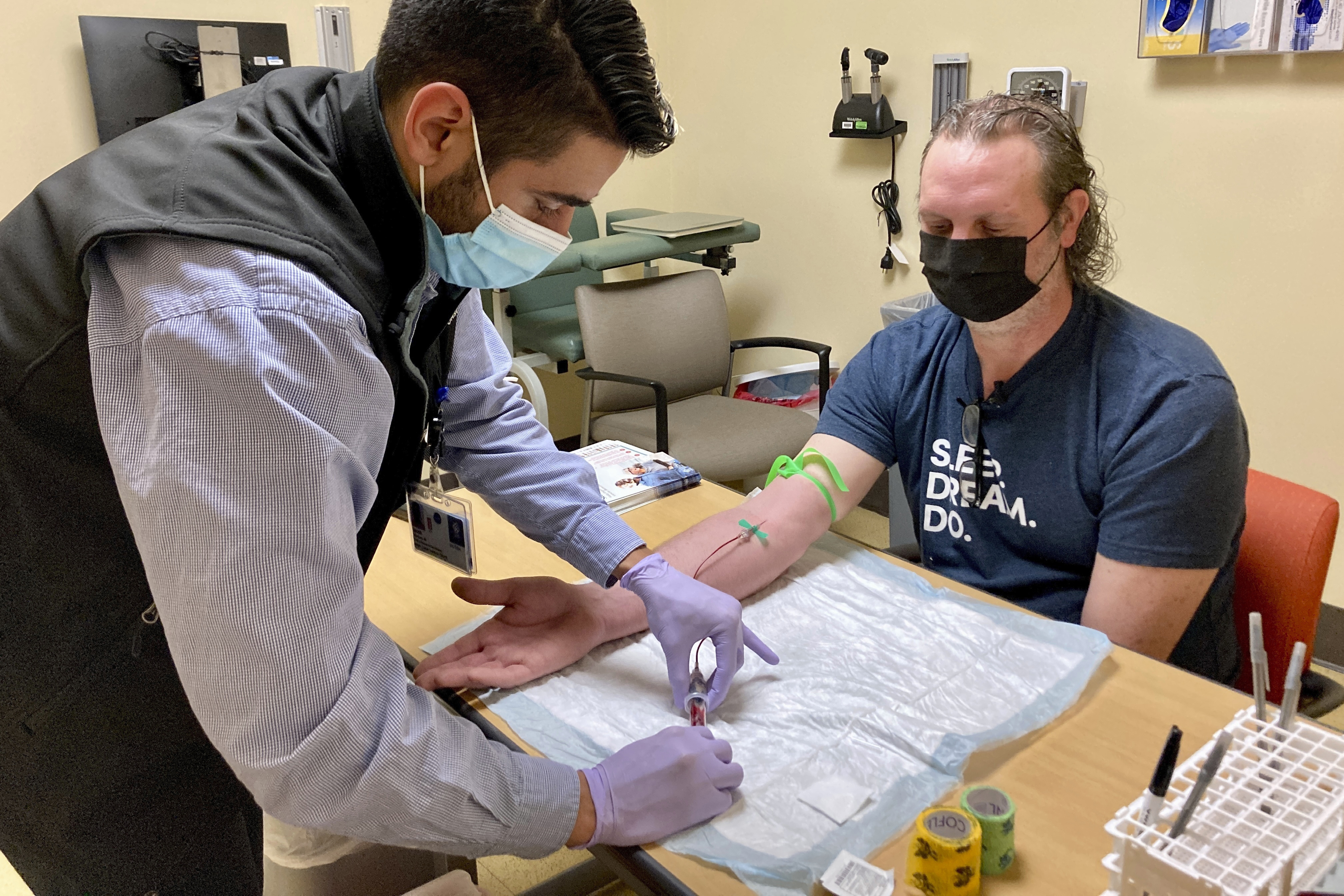
For a decade, Maria Sylvia had a tan streak on her nail. Doctors told her it was a mole and nothing to worry about. After a colleague urged her to get it examined again, Sylvia learned it was a rare skin cancer, called subungual melanoma, and shared her experience on TikTok.
“This whole thing started with me just trying to cope with my trauma with dark humor,” Sylvia, 25, an analyst in Alexandria, Virginia, told TODAY. “When I saw that this was garnering an insane amount of attention I thought people should know more about this.”
A nail streak appears
Get top local stories in San Diego delivered to you every morning. >Sign up for NBC San Diego's News Headlines newsletter.
In high school, Sylvia played a lot of sports so when the tan streak appeared on her right thumbnail she thought maybe it was a blood blister or a bruise. When she visited a podiatrist for an ingrown toenail, the doctor recommended that Sylvia visit a dermatologist to have it examined.
“(The dermatologist) basically said it’s most likely a mole in your nail bed and it’s probably not going to be of concern because the alternative was like a 1% chance it was this cancer,” she said. “They basically told me to wait and watch and see if it got darker, grew wider.”
For the next several years, Sylvia thought little of the streak.
“I wasn’t concerned. I was like, ‘What are the odds?’” Sylvia recalled. “I would say, ‘Oh I was just told it was a mole under my nail bed. I grew to accept that it was just part of my hand.’”
Last fall, a former co-worker, reached out to Sylvia after reading something about subungual melanoma and encouraged Sylvia to see a dermatologist.

“She saw a picture that looked like my thumb and so she sent it to me, ‘You need to get this looked at,’” Sylvia said. “It’s almost like you don’t want to face it at that point because it’s scary.”
Sylvia started researching it and in January she made an appointment with a dermatologist.
“I owe it to my co-worker for creating a voice in the back of my head to get it looked at,” Sylvia said.
But the still dermatologist wasn’t sure about conducting a biopsy.
“He wasn’t even concerned. He was like, ‘Oh I don’t think it’ll be that,’” Sylvia said. “I’m like ‘OK, well I still want to get this biopsy done.’”
The doctor used a local anesthesia to numb the area and conducted a “punch biopsy,” taking a tiny patch of skin from the nailbed. Even as he finished the procedure, he felt confident the mark was just a mole.
“A week later, I get a call from him … he’s saying, ‘Hey we got your biopsy results back,’” she said. “He says, ‘We found melanoma.’”
What is subungual melanoma?
A subungual melanoma is a skin cancer that form in the finger or toe nailbeds.
“It’s a pretty rare subtype. However because of that it could be missed and could go on for years without being recognized,” Dr. Adam Friedman, chair of dermatology at George Washington School of Medicine and Health Science, who was not Sylvia’s doctor, told TODAY. “It can be certainly aggressive if not caught — that’s the rule of all melanomas.”
While subungual melanomas don’t frequently occur, nail discoloration is quite common. Fungal infections, bruises and moles can cause streaks on both finger and toe nails. People who work with heavy machinery, such as construction workers, often have multiple streaks in their nails.
“Vibrations can stimulate pigment production. That trauma can start stimulating the production,” Friedman explained. “The difference here is you would ... see multiple nail streaks. There shouldn’t be just one.”
People also develop moles under their nails. Much like moles on the rest of their body, they need to be mindful of changes to them.
“It gets a little tricker because how do you define it? Is it just a band from a healthy mole or is it band from a melanoma,” Friedman said. “Is that band getting wider and darker over time? Is there any injury to the nail itself?”
Often changes in the streak cannot be seen until the melanoma is advanced, which is why having regular skin checks with a dermatologist can help people understand what discoloration is normal — and what isn’t.
“Change over time is helpful, but the change over time will be slower in the nail because fingernails grow three millimeters a month. So that change may not be noticed as quickly,” Friedman said. “When in doubt, if there’s any confusion, or there’s a lack of clarity, if it could be on the fence, that’s where a biopsy could be helpful.”
Treating subungual melanoma
Sylvia’s doctor recommended she meet with an oncologist for treatment.
“All the doctors that I’ve seen are just flabbergasted by my case because I’m like the youngest person they’ve ever met with this cancer,” she said. “My oncologist informed me that I had stage zero … and it was good that I came in when I did because that means the cancer was isolated in the mole in my thumb.”
The oncologist wanted it removed within a month if possible and referred Sylvia to a Mohs surgeon, a doctor who removes skin cancer. But finding someone to treat her wasn't that straightforward. The first surgeon she met with felt uncomfortable performing the surgery as he had never treated a subungual melanoma before. He referred Sylvia to a doctor at Johns Hopkins who specialized in hand tumor removal.
“I was very happy that he was being very candid and honest with me saying that he wasn’t confident in this,” Sylvia said. “It also makes you scared because you’re like, ‘Why is it that no one feels confident doing this?’”
The surgeon at Johns Hopkins recommended “a wide excision” that removed the entire nailbed.
“Anything that might have creeped out of the mole would be removed,” Slyvia said.
But this required two surgeries. After successfully removing the nail bed and surrounding tissues, which showed the cancer had not spread, Sylvia needed to undergo a procedure that used skin from her forearm to cover the now nail-less thumb.
“(When) I actually saw my thumb for the first time I had an out of body experience,” she said. “It’s so horrible.”
It’s been tough because she can’t use her right hand very much and she’ll need physical therapy to move her thumb properly again . She is left handed but still uses her right quite a bit. She’ll never grow a nail again because of the surgery. Since sharing her story on TikTok, she’s heard from a lot of people who didn’t realize a mark on their nail could turn into skin cancer.
“People were interested to know more about it — so I found that sometimes oversharing on the internet can be beneficial,” Sylvia said. “I’ve had people reach out to me saying they were so grateful for me to share awareness.”
This story first appeared on TODAY.com. More from TODAY:




